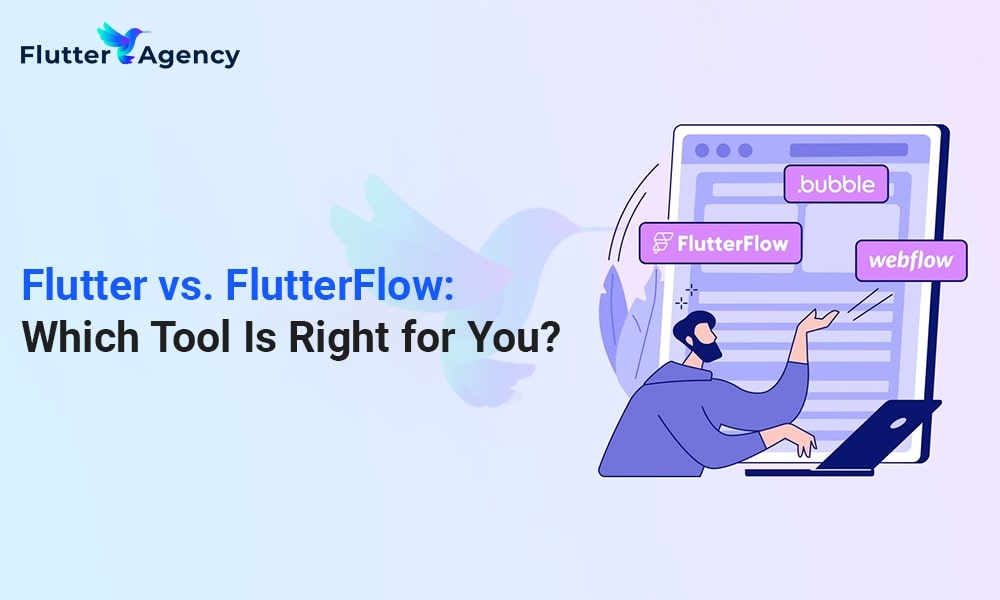Flutter vs. FlutterFlow: Selecting the Best Tool for Your Mobile App Development
Selecting the appropriate framework might be crucial while developing apps. The user experience, development time, and overall application effectiveness might all be impacted. Flutter vs. FlutterFlow is one of the most well-known platforms for developing cross-platform mobile applications. To assist you in choosing the best option for your app development work, we will carefully compare the features, benefits, and limits of both tools in this article.
Define Flutter
Using a single codebase, the open-source UI framework Flutter enables the development of cross-platform desktop, web, and mobile applications. Due to its rich widget library and support for the Dart programming language, programmers may utilize this to create visually beautiful and responsive user interfaces. Flutter’s “hot reload” feature is famous for allowing in-flight code modifications and expediting the development process.
There are many tools and solutions available because of the vast and active developer community of Flutter. Because it provides native code, Flutter is a popular choice for people looking for consistency and efficiency in app development. You can also hire Flutter developers to ensure high-performance applications on both iOS and Android platforms.
What Are the Benefits of Flutter?
Developing mobile apps with Google’s Flutter open-source UI framework has many benefits. The following are a few of the primary benefits of working with a Flutter app development company:
1. Rich Set of Widgets:
To design aesthetically pleasant and unified user interfaces across platforms, Flutter provides an extensive set of customizable widgets.
2. Fast Development:
The “hot reload” option lets developers immediately see the results of code changes, simplifying and streamlining the development and debugging process.
3. High Performance:
Flutter apps build high-performing applications that operate well on iOS when you hire an iOS developer since they compile native ARM code.
4. Expressive UI:
Expressive User interfaces can be created using Flutter, which offers complete control over every pixel on the screen.
5. Open-Source:
Being open-source denotes that it is freely usable and benefits from continuing community contributions and enhancements.
6. Platform-Aware Widgets:
Flutter widgets aim to imitate the platform’s native look and feel to provide a consistent user experience.
7. Localization and Internalization:
The development of apps for a broad audience is made simple by Flutter’s robust support for localization and internationalization.
8. Ecosystem Expansion:
The Flutter ecosystem is rapidly growing due to plugins, packages, and tools in Flutter that simplify development.
What Benefits Does FlutterFlow Provide?
FlutterFlow offers a wide range of significant benefits for people and teams looking to accelerate the development of apps, particularly for those without extensive coding experience.
1. No-Code/Low-Code Development:
Without writing complex code, non-developers may create functional apps using FlutterFlow’s beautiful user experience. By doing this, the development process speeds up, and designers and entrepreneurs are provided with the necessary resources to implement their ideas.
2. Rapid Prototyping:
It facilitates rapid prototyping, which enables you to quickly generate interactive prototypes of your app’s user interface and functionality.
3. Visual Design:
This platform provides a wide range of pre-designed UI widgets and components, making it easy to create user interfaces that are visually appealing and consistent without the need for extensive design expertise.
4. Integration Capabilities:
You may connect your app to essential services and data sources using FlutterFlow’s seamless integration capabilities with various databases, authentication schemes, and third-party APIs.
5. Export to Flutter:
Exporting your project as Flutter code is one of FlutterFlow’s most essential features. You can start with a visual strategy and hire developers for more demanding features or finer-grained customization.
6. Cross-Platform Capability:
The option to target both iOS and Android with a single project, thanks to FlutterFlow apps’ natural cross-platform nature, saves time and money.
Flutter vs. FlutterFlow: Choosing the Right Tool
There are several crucial factors to consider when choosing between Flutter and FlutterFlow, all of which should align with the particular needs of your project, the expertise of your team, and your development goals. Let’s examine these factors in greater depth to understand Flutter vs. FlutterFlow to help you decide:
1. Development Experience and Skills
Consider the overall experience of the people you hire. Choose Flutter for complete control and flexibility if you have experienced programmers familiar with Dart and Flutter. However, if your team consists of designers and non-technical team members, the no-code or low-code approach of FlutterFlow might be a better fit.
2. Project complexity
Analyze your software’s complexity. For applications with intricate updates, complex features, or particular performance requirements (such as games or real-time apps), Flutter’s authoring capabilities and direct compilation to native code may be helpful. For smaller projects or prototypes, FlutterFlow’s visual tools are sufficient.
3. Minimum Customization
Consider the design and customization needs of your app. If you need a highly customized user experience beyond what visual builders offer, you can create unique UI elements using Flutter’s flexibility in widget development.
4. Performance Requires
Examine the performance specifications of your software. Flutter’s direct compilation to native code might benefit apps that demand top-notch performance, such as 3D games or resource-intensive apps.
5. Design-Centered Approach
FlutterFlow’s visual design tools can help you create stunning user interfaces without writing a lot of code if the app’s aesthetic appeal and usability are your top priorities.
6. Prototyping and testing
If you aim to get user feedback through iterative development or prototype concepts quickly, FlutterFlow’s quick design-to-test cycle can be helpful.
Conclusion
In the Flutter vs. FlutterFlow competition, only so many solutions work for everyone. Your choice will depend on your project’s unique requirements, including your team’s skill set and your long-term development goals.
Flutter is a fantastic alternative for building high-performance, highly customizable apps, especially if you are comfortable with Dart. FlutterFlow, on the other hand, is a valuable tool for projects that emphasize design, rapid prototyping, and situations in which coding skills are limited.
Selecting a tool and mobile app development company compatible with your project’s specifications and your team’s expertise is vital to ensure a successful app development process.
Frequently Asked Questions (FAQs)
1. Is FlutterFlow superior?
Flutterflow’s user-friendly UI makes learning simple, and you may use it without any technical skills. Flutter takes more time to grasp, and you’ll need a tech team to maintain it and fix bugs. In this situation, FlutterFlow is the better choice to save money on maintenance.
2. What is the future of Flutterflow?
FlutterFlow is a promising platform with a bright future, as it democratizes mobile app development and enables businesses to build apps faster and more efficiently.
3. How effective is FlutterFlow?
It effortlessly integrates with coding, allowing you to use your existing skills. Rich UI/UX: It provides a large selection of widgets and design features, making it simple to make interactive user interfaces visually attractive. This UI/UX design’s richness is a remarkable feature.
Book Your Flutter Developer Now
Contemporary ventures
Recent blog
ready to get started?
Fill out the form below and we will be in touch soon!
"*" indicates required fields














